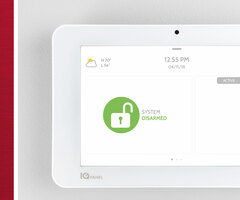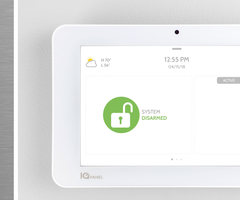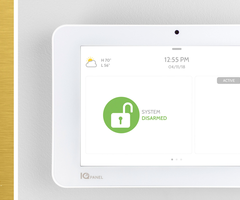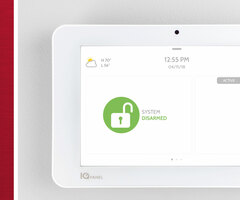How Does RF Supervision Work On the Qolsys IQ Panel 2?
RF Supervision on the Qolsys IQ Panel 2 works by having the sensors check-in with the panel periodically. If the panel does not receive a check-in signal within a set amount of time, then RF supervision loss will be displayed. This time can be set for 4 hours, 12 hours, or 24 hours.
 RF supervision loss means that the panel hasn't receive a check-in signal from the sensor within a set amount of time. This can because the sensor is completely powered down, or because the sensor has been taken outside of RF transmitting range from the panel. Either way, the panel cannot detect the sensor. You need to bring the sensor within range of the panel with the sensor powered on and transmitting properly for the condition to clear. The condition will clear once the sensor successfully sends a check-in signal to the panel. You can also try faulting and restoring the sensor (intrusion sensors) or pressing its test button (life-safety sensors) to transmit a signal from the sensor to the panel. Remember to put your system on test mode before pressing the test button on a life-safety sensor.
RF supervision loss means that the panel hasn't receive a check-in signal from the sensor within a set amount of time. This can because the sensor is completely powered down, or because the sensor has been taken outside of RF transmitting range from the panel. Either way, the panel cannot detect the sensor. You need to bring the sensor within range of the panel with the sensor powered on and transmitting properly for the condition to clear. The condition will clear once the sensor successfully sends a check-in signal to the panel. You can also try faulting and restoring the sensor (intrusion sensors) or pressing its test button (life-safety sensors) to transmit a signal from the sensor to the panel. Remember to put your system on test mode before pressing the test button on a life-safety sensor.
The IQ Panel 2 will not display RF supervision loss as soon as the sensor is powered down and/or taken outside of RF signal range. Instead, you set a time period for emergency sensors and non-emergency sensors. The panel must receive a check-in signal from each sensor of that type within the set time period. If the panel does not receive a check-in signal from a sensor within the set time period, then RF supervision loss will be displayed. The condition will clear once the sensor successfully transmits to the panel and checks-in.
You will know that a sensor is experiencing a loss of RF supervision because the panel will display an "Unreachable" condition for that zone. This status can be identified by a Question Mark. You can see that status condition, as well as other status conditions in the table below.

Please note that wireless sensors for the Qolsys IQ Panel 2 send check-in signals at different intervals. These intervals depend on the sensors that are being used. Most sensors used with the IQ Panel 2 will send check-in signals every 60 to 90 minutes. As long as the panel receives at leave one (1) check-in signal during the set time (4 hours, 12 hours, or 24 hours), then no RF supervision loss condition will be displayed. Since these sensors are designed to send out signals every 60 to 90 minutes, the panel should really receive multiple check-in signals from each sensor, even when using the shortest check-in requirement of at least once every 4 hours.
Note: DSC PowerG Sensors are known to send out check-in signals more frequently than most other sensors used with an IQ Panel 2 Plus System. As long as the panel receives a check-in signal from a programmed PowerG Sensor within the set time (emergency sensors vs. non-emergency sensors), no RF supervision loss condition will occur.
Some RF supervision loss issues occur due to changes in environment. In other words, some new environmental factor is now preventing sensor check-in signals from properly reaching the panel. This could be due to a new large metal appliance in the area (e.g. a new refrigerator, etc.), new walls, or even a new mirror in the sensor's communication path. Consider these factors if you are suddenly experiencing supervision troubles for your system.
There are two (2) settings within Installer/Dealer Settings for RF supervision. There is a setting for emergency sensors (e.g. life-safety sensors like smoke detectors, heat detectors, and CO detectors) and non-emergency sensors (e.g. intrusion sensors like door and window contacts, motion sensors etc. and environmental sensors like temperature sensors, flood sensors, etc.). For both emergency sensors and non-emergency sensors, you can require a check-in period of every 4 hours, every 12 hours, and every 24 hours. Emergency sensors and non-emergency sensors are set separately.

To access the menu where you can change the RF supervision check-in requirements for emergency and non-emergency sensors, start by pressing the small grey bar at the top of the main screen. Choose Settings > Advanced Settings > enter Installer or Dealer Code (default 1111 and 2222 respectively) > Installation > Installer or Dealer Settings > scroll down to the Supervisory section. Once you finish making the changes, you can press the picture of the house at the bottom of the screen to return to the main menu. All changes will be saved automatically.
Did you find this answer useful?
We offer alarm monitoring as low as $10 / month
Click Here to Learn MoreRelated Products






- Answered
